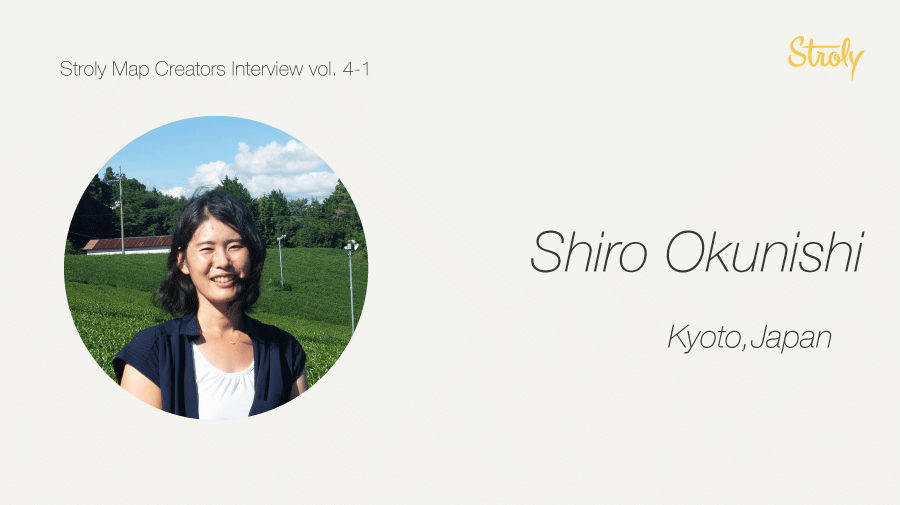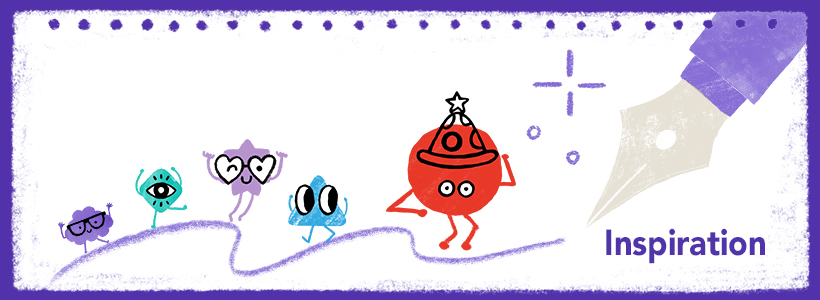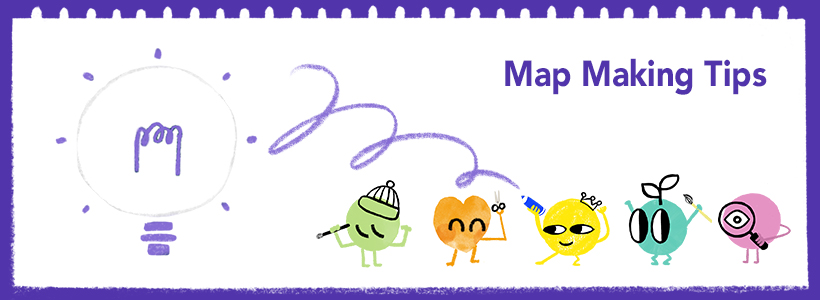A stunning view of tea fields between mountain ravines. Here in Minamiyamashiromura, the only village in Kyoto Pref. is famous as a tea-producing area.
Ms. Shiro Okunishi lives in such a lovely place. She works in the design industry and has been uploaded many maps on Stroly. I have the privilege of interviewing her. Let me share with you what her focuses are as a map artist.
[Tell us more about you]
– Could you tell us how you started drawing illustrations?
I’ve loved drawing since I was a kindergartner.
From elementary school to high school, my dream was to be a manga artist.
I would draw manga on manuscript paper and submit it to publishers. It didn’t work out.
After that, I really pondered about what career path could I take. So I decided to follow my passion for painting and go to study design at an art university.
– What university did you go to?
I went to Tokyo Zokei University. I would commute to school from my hometown of Yokohama.
It was nice a really great experience, but there was a time when I didn’t feel like that and wanted to drop out.
Back then, I was feeling uneasy and kept asking myself , “Why am I designing? There are better designers out there.”
But then I took a class that led me in a different direction. It was in my third year, and
the class was about creating your own book by having workshops. I found it very interesting to create something while interacting with people. My love for design was reignited.
Also, I enjoyed taking pictures and walking in many cities or towns such as old towns in Tokyo. Eventually, I found out my original interest is in towns themselves.
– Do you walk around towns alone?
Yes. It feels more like a hobby than work. Around that time, I met a person whom I respect the most.
His name is Makoto Umebara. He designs mainly for the Primary sector and focuses on the charm of each regions. His job is to help promote and keep the tradition, customs, and scenery of these areas.
When I found out what he did for a loving, I said to myself, “I want to do this job”.
– Meeting him sounds like a turning point for you! When did this happen?
It was when I was 19 or 20 years old.
Thanks to that experience, I joined a community, then I entered a program of the MLIT (Ministry of Land, Infrastructure, Transport, and Tourism) that sends university students to various areas during summer vacation.
– Where did you go?
I went to Hikawacho, Kumamoto Prefecture. It was just for two weeks, but even after that, I went there regularly and helped the local people with logging bamboos or helped mandarin farmers make flyers for gift packages. When I was making a custom eraser stamp with a design of her face, I became strongly convinced that there is a need for design at community level, because it helps deliver positive effects and share the message of these local makers. So that’s how I aimed to become a designer.
– Where do you get your inspiration?
Right now, I get inspiration mainly from village landscapes. I draw only when I get impressed by something and want to tell someone about it.
For example, I have this booklet named “Minamiyamashircho book” which exhibited for 3 years. The first booklet was a brief introduction to the area. The second was made with the theme of “calendar”. This year, the concept for the booklet was “dialect”. I will continue to set a theme every year.

– We often feel that a map with illustrations can deliver a unique point of view.
I agree. Photographs can be used too, but I use illustrations because I like to paint.
– What are your interests at the moment?
Children for now. My child is still small, but when she is a bit older, I want to make an exploration map of this area. I also want to make more booklets.
I’m thinking of what can we do together.
– Sounds exciting! I would like to see the exploration map once it’s ready.
Thank you. I’ll publish it on Stroly.
– When did you start drawing maps? When you were a university student?
No, I liked maps and collected piles of them since my university days, but I started creating maps when I started working.
After my graduation, I worked for a plant dyeing factory in Fukuoka Pref. for about a year and then worked for a company in Kyoto.
The company had a custom of making for employees’ birthdays, and I started making maps for that purpose.
Here is one of the maps.

The birthday person likes to eat around, so I asked other employees their recommendations so I made this gourmet book of Kyoto.
I think this is the first map I’ve made.
The map is made with an eraser stamp technique.
– Do you often use a stamps?
Yes, I often use them in my designs.
[Tell us about your style]
When I was working for the company in Kyoto, I attended a design school called “Moone Kobo” for three years.
It was a place where not only professionals but office workers and housewives came to learn. I learned a lot about practical and daily life design. I made various kinds of paper, textiles, and pottery, etc.
During my third grade, there was a graduation exhibition with the theme of “Create a Fictional Shop”, and I made a “travel agency”.
By this time, I had already visited all the 47 prefectures in Japan, and I wanted to make an exhibition that featured the charm of every prefecture of Japan. I made a map with souvenirs from various places, wrote memories for image photographs of each prefecture, and created some journal books of my trips.
For example, the journal book about Morioka, Iwate Pref., was designed as a picture book with photographs and maps. The theme of Kagoshima’s book is “rough” because I felt the landscape itself was not delicate. So I designed the books with the image of the region in mind.
– Interesting. So your designs change depending on the features of each prefecture.
Indeed. When I design, my main focus is on how I can best express the charm of this region?
– Are there other things you make an emphasis on?
I think the motivation or goal of the map is very important.
Even “fun” maps wouldn’t make sense if it don’t lead you anywhere.
I like to make inspiring maps that make readers want to go and see those places.
– What are the necessary elements for an exciting motivational map for you?
Well, I’d say.. how much of your voice is included in the map.
It’s hard to make a map of places you’ve never visited. It’s important that you actually see them, feel the atmosphere and make the map with the mindset of, “Oh, I really want people to know more about this place”.
With that in mind, I started drawing a picture journal starting in 2016.
Even if it was a bit trivia, I drew something about my day and uploaded it to Instagram.

– These illustrations seem to be a good cue for you to look back at the journal later. They will remain in your memory.
Yes. I look it back and I remind myself about that day.
I am currently working on a childcare journal, and I illustrate my daily life if I find something impressive.
I usually draw on this regular notebook, but recently it has become too small and now I work on larger format.
This is a map of Ishikawa Prefecture(Ishikawa Travel Map) I visited this summer.

-The size of the original map seems smaller than I expected.
I tend to draw small.
– Do you often draw with a ballpoint pen?
Yes, it’s just an ordinary brand pen named “Signo”.
I use roughly four pens, 0.5, 0.28, 0.38, and bold. Very simple, right?

– I see. You switch between pens depending on what you draw, and that gives variety in your illustrations. Do you travel a lot?
I traveled a lot when I was single, but not so much since I got married. Now is about twice a year.
– Do you draw a map every time you travel?
Yes, I draw maps when I go for long trips as well as one-day trips.
The Gion Festival map was a journal of our family’s one-day trip.
– I liked it. The message “walking around bukkoji-street is less packed” was a unique but helpful piece advise, especially for events like Gion Festival that are full of people.
I’m glad to hear that because I want my work to be helpful.
Particularly, I want to tips to moms about good places they can go or travel even with children.
– How long did it take to finish this map? A day?
I think it was about 2 hours.
– That is fast!
I try not to spend too much time. I try not to push too hard so I can enjoy the process.
– I see. What is the most fun part about drawing a map?
I feel happy and have a sense of accomplishment when I give a form to my creations or ideas.
– On the contrary, is there anything you find difficult?
I’d say a composition for some places. How to cut out landscapes.
I think it’s easy to draw if there’s a unique terrain like Ishikawa Pref.
– It can be difficult to draw a downtown then. Oh, I was really curious about this elephant’s nose park.
Yeah. I don’t call this a map. it’s more like just an illustration.
– Nah, it’s a map for me!
I think it’s amazing that with Stroly, a very rough image can be a map.
I like it because it doesn’t require too much detail.
– My feelings exactly! Do you actually go to see a place and draw what you saw, even for work?
Correct. In addition to that, I emphasize a part that I received a strong impression and that I wanted to appeal to.
– I’m not very good at emphasizing appealing parts. Any tips?
If you actually go and see a place, you can somehow prioritize it, doe it make sense? Like “oh, here I enjoyed the most” or “I liked it the most.”
– I see. Be honest with your impressions and express it on a map rather than depending on the information you gathered or heard from others.
Exactly. For beginners, I think it would be easier to follow your feelings and draw a map than having rules on how to.
…
The interview continues in the second part.
Click here for the second part2: Map creator who delivers the charm of the region! Interview with Ms. Shiro Okunishi.
You can find more works of Ms.Shiro Okunishi on Stroly.com
Check follows for the latest information
TamagoTravel(HP) , Facebook Page, Instagram, Instagram (Child Care Diary)



